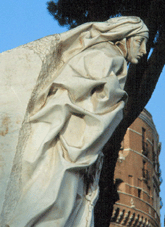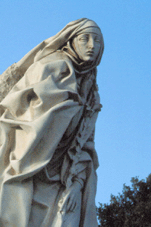Saint Catherine Statue

Public Art: Saint Catherine Statue
Also Known As: Statua di Santa Caterin and Saint Catherine of Siena statue
Sculptor: © Francesco Messina (December 15th, 1900 – September 13th, 1995)
Date: The statue was erected in 1961
Location: The statue is located at Piazza Pia, Rome, Italy in a flowerbed in the gardens around Castel Sant’Angelo and the Vatican.
Description: The statue of St Catherine is carved from marble and includes 4 bas-reliefs of her life at the base. The main feature of the carving is her long cloak which seems to all but encompasses her. If you happen to glimpse St Catherine at the right time of day you would almost swear she is moving at great haste, through the wind and the elements to help save a poor soul.

Brief Background of Saint Catherine: So who is Saint Catherine? Some may know her as Caterina Benincasa, an Italian Dominican mystic, but to many, she is, along with St Francis of Assisi, the patron saint of Italy. Commonly referred to as Saint Catherine of Siena she was born Caterina Benincasa on the 25th March 1347 one of 25 children. Yes, that’s right, her mother gave birth to 25 children.
At the age of six, Caterina is believed to have had her “first vision”. During a walk with one of her brothers, she was visited by Christ and two saints, John and Paul. The following year a young Caterina pledged her virginity to God, which didn’t make her mother Lapa all that happy, especially in later years when she tried fruitlessly to matchmake her with potential suitors. During one particular episode, Caterina cut off her hair in defiance of her mother’s continued meddling. Eventually, Lapa gave up and became resigned to the fact her daughter was never going to marry.
A small room was set up at the top of the family home where Catherine would fast, meditate, pray and self-flagellate. For three years she remained pretty much a recluse until at the age of 20 she went to a mass and experienced yet another vision, which she described as a “Mystical Marriage” with Jesus. When Christ came to her this time she was told to ” love her neighbor as herself and to serve Christ in the neighbor.” Well, with this new vision it gave her a whole new direction in life, she was soon seen out and about helping the sick, poor and needy.
It wasn’t long before the news got back to the Dominican Order about this strange woman of Siena and in 1374 she was called to Florence to be interrogated for heresy. All ended well, passing her heresy interrogation with flying colors and being deemed sufficiently orthodox. Upward and onward. Catherine, now with a stamp of approval traveled further afield within Italy launching a “total love for God” crusade, which included attacking clergy for their desire for wealth and status.
There are many conflicting stories about whether Catherine was illiterate or not but one thing is for certain, she was able to use her letter writing skills (dictated or not) to reach a wider audience. Many of her letters begged for peace and the return of the Papacy from Avignon (now France) back to Rome. Pope Gregory XI ( Avignon Pope) was one of her greatest correspondents and in 1376 she traveled to Avignon to met him face to face. By the following year, the Pope’s administration had returned to Rome.
When Pope Gregory died in 1378 all hell broke loose, the Catholic Church suddenly became divided. Two men simultaneously claimed to be the true pope, one in Rome (Pope Urban VI) and one in Avignon (Pope Clement VII ). Of course, Catherine sided with Pope Urban VI and spent a good deal of time in Rome convincing nobles and cardinals of his legitimacy. This Papal Schism would not be resolved until 1417 long after the death of Catherine. In fact, Catherine would only live until the spring of 1380.
Catherine collapsed and died in Rome from a stroke at the age of 33. Over 300 of the letters she wrote still exist today.
OK and now for some morbid details. When news of Catherine’s death reached Siena, the people wished for her body to be returned to her hometown. Knowing full well there was no way they could steal her whole body, they decided to remove just her head and thumb. They placed it in a bag and fled from Rome but were stopped by some Roman guards. In fear of being caught as body snatchers, they prayed to St Catherine. Low and behold when the soldiers took a peek into the bag all they saw were rose petals. This is why you often see images of Saint Catherine holding a rose.
Catherine’s head and thumb now lie buried in the Basilica of San Domenico in Siena and her body (minus head and one digit) is buried in the Basilica of Santa Maria Sopra Minerva in Rome.
In 1461 Pope Pius II canonized St Catherine (her feast day being April 29) and on 5th May 1940, Pope Pius XII named her a joint Patron Saint of Italy along with Saint Francis of Assisi. Wait, there’s more, in 1970 Pope Paul VI gave her the title of Doctor of the Church and in 1999 Pope John Paul II made her one of Europe’s patron saints.